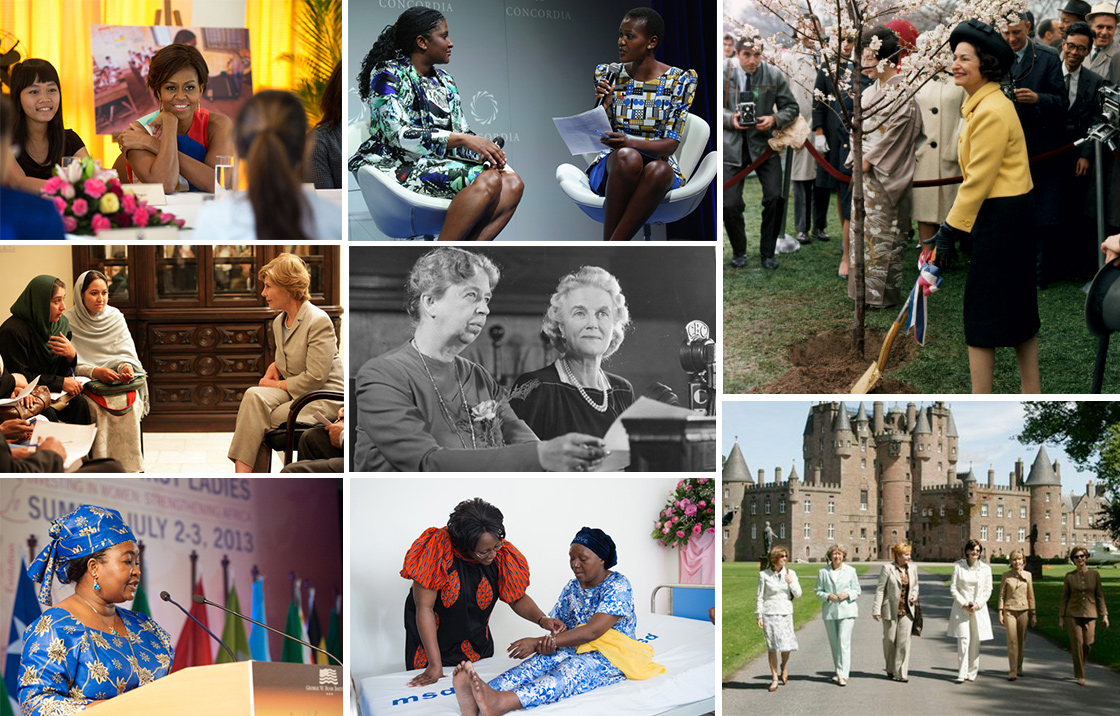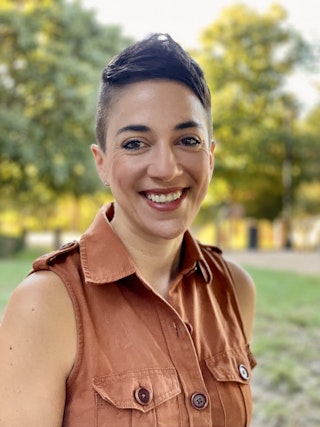Breaking Down Silos: The Leadership of African First Ladies
First ladies across the globe have the ability to impact change through their influence and advocacy on important issues. The Bush Institute’s Natalie Gonnella-Platts visited a small classroom in Windhoek, Namibia and witnessed the leadership of African first ladies.
 (R-L) Ms. Jimmy, First Lady Monica Geingos, Mrs. Laura Bush, and President Bush. (Paul Morse / George W. Bush Presidential Center)
(R-L) Ms. Jimmy, First Lady Monica Geingos, Mrs. Laura Bush, and President Bush. (Paul Morse / George W. Bush Presidential Center)
Delphia Jimmy’s Life Skills class occupies a small but orderly room at Ella du Plessis High School on the outskirts of Windhoek, Namibia. Desks are neatly grouped to maximize space and opportunities for dialogue. The bulletin boards that surround the room are brightly decorated to emphasize information on HIV/AIDS, teen pregnancy, and drug and alcohol abuse. As students shuffle in, they seamlessly take their seats and get to work discussing an article on gender-based violence and brainstorming solutions for prevention and survivor support.
In seeking to gain a better understanding of the work of First Lady Monica Geingos, Ms. Jimmy’s classroom was at the top of my itinerary during my first visit to Namibia earlier this year. For a vast number of students at Ella du Plessis and other secondary schools in low- income communities, Life Skills classrooms like Ms. Jimmy’s are a vital refuge. They provide an outlet to speak openly about issues that have a direct and daily impact on their communities, their families, and their future.
According to economic data, Namibia ranks as an upper-middle income country, excluding it from various categories of foreign aid and investment. Yet, at the same time, the country contends with one of the highest rates of wealth disparity in the world.
Outside of popular tourist destinations and affluent areas of the capital, poverty remains a prevalent challenge. I am told that of the young people that entered Grade 8 in 2011 and 2012, barely 36% fully matriculated to Grade 12, let alone continued onward to tertiary education.
That equates to over 22,000 student dropouts across these two class years alone. A concerning sum for a population of only 2.4 million that includes the highest proportion of 15-24 year olds in the world (23% of the total populace).
The First Lady’s Be Free campaign strives to “encourage open and frank dialogue between adolescents and their parents, guardians and other adults” on social matters that have a profound impact on their success and well-being. Recognizing the influence of her platform, Madame Geingos has joined forces with both formal and informal partners – including students and teachers like Ms. Jimmy – to better understand youth challenges and offer a lifeline for support and collaboration.
 Students at Delphia Jimmy's Life Skills class at Ella du Plessis High School in Windhoek, Namibia present what they have learned to President and Mrs. Bush and Madame Geingos. (Paul Morse/George W. Bush Presidential Center)
Students at Delphia Jimmy's Life Skills class at Ella du Plessis High School in Windhoek, Namibia present what they have learned to President and Mrs. Bush and Madame Geingos. (Paul Morse/George W. Bush Presidential Center)
Active engagement with local communities is at the heart of the effort, and regardless of locale, one is hard pressed to find a Be Free event where youth representation does not take center stage. “Young people have changed the way they talk and we need to speak their language so we can reach them in a way they can relate,” notes Madame Geingos.
“Young people have changed the way they talk and we need to speak their language so we can reach them in a way they can relate.”
– Madame Monica Geingos
For the First Lady’s team, Ms. Jimmy’s perspective and the views of her students are an important resource. By working together, they are making progress in disrupting misconceptions and factors that contribute to deeply-entrenched poverty cycles. And this is not exclusive to Namibia.
A number of first ladies across Africa have worked to galvanize support and attention around leading challenges for women and girls in their countries and across the globe. They have done so through building bridges between government institutions and civil society.
In Malawi, First Lady Gertrude Mutharika has focused on health and hygiene, engaging faith based institutions, local non-profit organizations, and community leaders in seeking solutions.
Ethiopian First Lady Roman Tesfaye founded the Ethiopian National Cancer Control Committee and supported the creation of the country’s first National Cancer Control Plan. Her efforts have increased regional attention on the need for improved treatment systems in combatting non-communicable diseases and the value of public private partnerships, such as Pink Ribbon Red Ribbon.
First Lady Esther Lungu in Zambia has connected with chiefs in rural areas to curtail child marriage and ensure that girls remain in school. And during her time in office, Dr. Christine Kaseba-Sata, former First Lady of Zambia, worked to encourage support and action for issues around gender-based violence and improvements to maternal and infant health.
As a longstanding advocate for women and girls, former Tanzanian First Lady “Mama” Salma Kikwete actively used her platform to engage with local community organizations to break down stigmas and promote critical interventions around women’s cancers and other family health challenges. For example, in collaboration with Pink Ribbon Red Ribbon and local partners, Mama Kikwete led a mass screening for cervical cancer in Mwanza in March 2014 to celebrate International Women’s Day.
That was the coalition’s first official activity in Tanzania, and local partners worked to train health providers on screening and treatment. They also reached out to local communities. As a result of the cooperation among stakeholders, over 5,000 women were screened for breast cancer and over 3,200 for cervical cancer. Those numbers were significantly more than anticipated. After the first mass screening campaign led by Mama Kikwete, this model has been replicated with further success.
And from Ghana to Mozambique, first ladies across the continent are working together through the Organization of African First Ladies Against HIV/AIDS to raise their voices and petition action to address HIV/AIDs, cervical cancer, and other related health concerns.
 Former Tanzanian First Lady Salma Kikwete at the Bush Institute's African First Ladies Summit in 2013. (Grant Miller/George W. Bush Presidential Center)
Former Tanzanian First Lady Salma Kikwete at the Bush Institute's African First Ladies Summit in 2013. (Grant Miller/George W. Bush Presidential Center)
Change happens when we break down silos and work together. With an apolitical yet official role, first ladies have the capacity to spur engagement between citizens and their leaders. Moreover, as both listeners and facilitators, their leadership brings focus to the voices and needs of those who may otherwise be overlooked. Case in point: Madame Geingos’s leadership on youth empowerment.
Change happens when we break down silos and work together. With an apolitical yet official role, first ladies have the capacity to spur engagement between citizens and their leaders.
As Africa aims to accelerate growth and development, collaboration among stakeholders is vital. And many first ladies across the continent have taken note, attempting to bring change to the continent through building bridges.
-
Previous Article Africa's Hopeful Future: A Look at Tomorrow’s Opportunities and Challenges A Collection of Essays from African Authors
-
Next Article How HIV, SARS, and Ebola Put Global Health on the Agenda An Essay by Ambassador Mark Dybul, Professor of Medicine at Georgetown University School of Medicine, and former United States Global AIDS Coordinator


